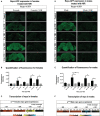Inhibiting Mitochondrial Cytochrome c Oxidase Downregulates Gene Transcription After Traumatic Brain Injury in Drosophila
- PMID: 33790803
- PMCID: PMC8005633
- DOI: 10.3389/fphys.2021.628777
Inhibiting Mitochondrial Cytochrome c Oxidase Downregulates Gene Transcription After Traumatic Brain Injury in Drosophila
Abstract
Traumatic brain injuries (TBIs) caused by a sudden impact to the head alter behavior and impair physical and cognitive function. Besides the severity, type and area of the brain affected, the outcome of TBI is also influenced by the patient's biological sex. Previous studies reporting mitochondrial dysfunction mainly focused on exponential reactive oxygen species (ROS) generation, increased mitochondrial membrane potential, and altered mitochondrial dynamics as a key player in the outcome to brain injury. In this study, we evaluated the effect of a near-infrared (NIR) light exposure on gene expression in a Drosophila TBI model. NIR interacts with cytochrome c oxidase (COX) of the electron transport chain to reduce mitochondrial membrane potential hyperpolarization, attenuate ROS generation, and apoptosis. We subjected w 1118 male and female flies to TBI using a high-impact trauma (HIT) device and subsequently exposed the isolated fly brains to a COX-inhibitory wavelength of 750 nm for 2 hours (hr). Genome-wide 3'-mRNA-sequencing of fly brains revealed that injured w 1118 females exhibit greater changes in transcription compared to males at 1, 2, and 4 hours (hr) after TBI. Inhibiting COX by exposure to NIR downregulates gene expression in injured females but has minimal effect in injured males. Our results suggest that mitochondrial COX modulation with NIR alters gene expression in Drosophila following TBI and the response to injury and NIR exposure varies by biological sex.
Keywords: gene expression; mitochondria; near-infrared light; sex-differences; traumatic brain injury.
Copyright © 2021 Shah, Hüttemann, Sanderson, Gurdziel and Ruden.
Conflict of interest statement
MH and TS are co-founders of Mitovation Inc., that develops infrared light therapy for ischemia/reperfusion injury applications. The remaining authors declare that the research was conducted in the absence of any commercial or financial relationships that could be construed as a potential conflict of interest.
Figures






Similar articles
-
Drosophila Exhibit Divergent Sex-Based Responses in Transcription and Motor Function After Traumatic Brain Injury.Front Neurol. 2020 Jun 19;11:511. doi: 10.3389/fneur.2020.00511. eCollection 2020. Front Neurol. 2020. PMID: 32636795 Free PMC article.
-
Mild traumatic brain injury in Drosophila melanogaster alters reactive oxygen and nitrogen species in a sex-dependent manner.Exp Neurol. 2024 Feb;372:114621. doi: 10.1016/j.expneurol.2023.114621. Epub 2023 Nov 27. Exp Neurol. 2024. PMID: 38029809 Free PMC article.
-
Quantitative detection of the expression of mitochondrial cytochrome c oxidase subunits mRNA in the cerebral cortex after experimental traumatic brain injury.Brain Res. 2009 Jan 28;1251:287-95. doi: 10.1016/j.brainres.2008.11.034. Epub 2008 Nov 21. Brain Res. 2009. PMID: 19063873
-
Transcranial, Red/Near-Infrared Light-Emitting Diode Therapy to Improve Cognition in Chronic Traumatic Brain Injury.Photomed Laser Surg. 2016 Dec;34(12):610-626. doi: 10.1089/pho.2015.4037. Photomed Laser Surg. 2016. PMID: 28001756 Review.
-
Treatments for traumatic brain injury with emphasis on transcranial near-infrared laser phototherapy.Neuropsychiatr Dis Treat. 2015 Aug 20;11:2159-75. doi: 10.2147/NDT.S65809. eCollection 2015. Neuropsychiatr Dis Treat. 2015. PMID: 26347062 Free PMC article. Review.
Cited by
-
Sometimes less is more: inhibitory infrared light during early reperfusion calms hyperactive mitochondria and suppresses reperfusion injury.Biochem Soc Trans. 2022 Oct 31;50(5):1377-1388. doi: 10.1042/BST20220446. Biochem Soc Trans. 2022. PMID: 36066188 Free PMC article. Review.
-
Comparative studies of genomic and epigenetic factors influencing transcriptional variation in two insect species.G3 (Bethesda). 2022 Nov 4;12(11):jkac230. doi: 10.1093/g3journal/jkac230. G3 (Bethesda). 2022. PMID: 36137211 Free PMC article.
-
Drosophila as a model to explore secondary injury cascades after traumatic brain injury.Biomed Pharmacother. 2021 Oct;142:112079. doi: 10.1016/j.biopha.2021.112079. Epub 2021 Aug 27. Biomed Pharmacother. 2021. PMID: 34463269 Free PMC article. Review.
-
Sex-Differences in Traumatic Brain Injury in the Absence of Tau in Drosophila.Genes (Basel). 2021 Jun 14;12(6):917. doi: 10.3390/genes12060917. Genes (Basel). 2021. PMID: 34198629 Free PMC article.
References
Grants and funding
LinkOut - more resources
Full Text Sources
Other Literature Sources
Molecular Biology Databases
Miscellaneous

